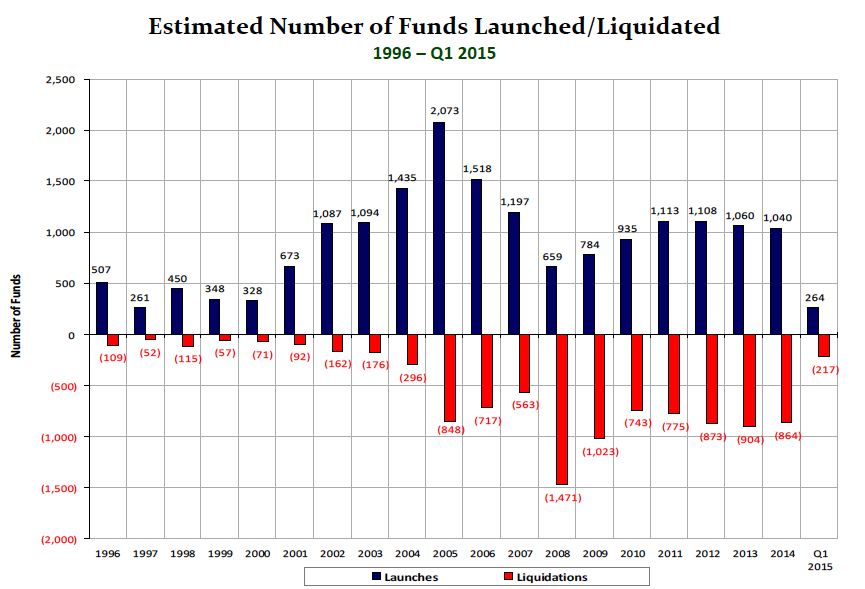The number of hedge funds available to investors has remained largely constant since the crisis, while performance has become more dispersed and fees are falling, research has found.
Since 2011, there has been an annual average 1,080 new hedge funds opening around the world, with an average 854 closing up shop, according to Hedge Fund Review (HFR). This cycle has led to an average net 226 increase in the number of funds available, compared to soaring figures in the first half of the last decade.
In the first quarter of 2015, the sector saw 264 hedge fund launches and 217 liquidations, putting it on target to sit in line with last year’s overall result, should it continue in a similar pattern.
“The environment to launch new funds continued to be challenging, with managers balancing increased demands for performance, transparency, liquidity and complex regulation.” —Kenneth Heinz, HFRBetween 2001 and 2005, the number of annual hedge fund launches grew from 673 to a record 2,073. At the start of the decade, closures were much lower than the present day with 92 closing in 2001. This grew to hit 848 closing in 2005, and after a spike in 2008, has remained relatively consistent around that number.
The slight difference between the newly opening and closing funds in the recent past has pushed the number available to investors to a record high, HFR said. At the end of March there were an estimated 10,149 funds operating around the world and managing a record $2.94 trillion.
“The environment to launch new funds continued to be challenging, with managers balancing increased demands for performance, transparency, liquidity and complex regulation,” said Kenneth Heinz, president of HFR. “While allocating to newly launched emerging managers requires investors to bear incremental, firm-specific risk, investors are compensated for these idiosyncratic risks through innovative strategies, access to capacity and dynamic, early-stage fund performance.”
Dispersion in performance between the top and bottom quartiles grew wider in the first quarter of the year. The best funds gained an average 12%, while the worst lost 7.6%. Added into a 12-month rolling average, it pushed the top decile to a 35.5% outperformance and the bottom to a 20.7% loss—amounting to a 56.2 percentage-point dispersion.
These numbers showed a greater dispersion than in the calendar year 2014, which saw top performers grow 27.4% and the bottom lose 19.5%, resulting in a 46.9 percentage point dispersion.
Despite a fairly consistent level of launches in the sector, funds opening in 2015 priced themselves slightly lower than their comrades did in 2014, HFR found. The 2015 vintage has demanded an average management fee of 1.52%, representing a five basis point fee reduction over those launched in 2014.
Average management fees have also fallen to 17.04% for launches in 2015, representing a 31 basis point decline over the 2014 set.
 Source: HFR
Source: HFR
Related: Hedge Funds Beat 2014 Returns… Already & How HF Managers Are Wasting Alpha
